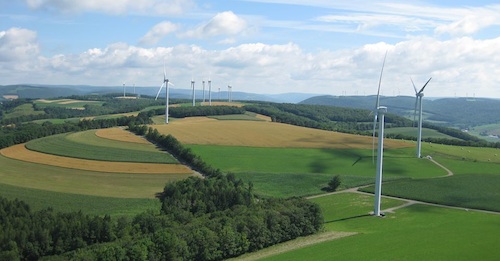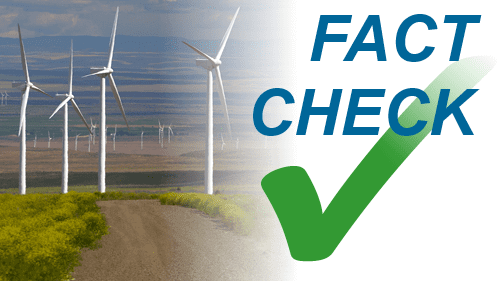Fact check: Correcting math errors leads back to original finding: Wind power is affordable, reliable
I’d like to thank Mr. Bushnell for his positive words about wind energy, including that wind “is a strong viable component of NorthWestern’s energy portfolio.” However, Mr. Bushnell’s criticisms of how wind energy is integrated onto the power system contain three salient math errors that cause him to greatly overstate the challenge. Correcting for those errors leads back to the original conclusion expressed in Jeff Fox’s article that wind energy is being reliably integrated at lower cost than coal generation.

Accommodating the failure of large conventional power plants is a significant burden for grid operators, as these typically occur instantaneously and without warning, requiring grid operators to keep hundreds or even thousands of megawatts of fast-acting reserves on standby at all times. In contrast, changes in wind output occur gradually and predictably, allowing grid operators to accommodate them at lower cost. In reality, grid operators are able to rely on a significant share of wind plant capacity for meeting peak electricity demand. While that share is higher for fuelled power plants like Colstrip #4, it is still well short of 100%, as evidenced by the fact that in 2 of the last 4 years the Colstrip #4 plant was totally unavailable during peak demand periods. This is not to say that fossil-fired power plants are unreliable, but rather to illustrate that the power system is operated reliably even though all individual power plants, including wind plants, do not always produce when needed.
2. Adding wind plants does not increase the need for power plant capacity, but rather actually decreases the need for power plant capacity. Because of reduced electricity demand and increased use of tools like demand response, most power systems in the U.S. have no need for additional power plants to meet electricity demand, so the value of capacity is very low or zero. Even if a power system does need additional capacity, adding a wind plant makes some contribution to that need. If the system does need more capacity, that need is caused by electricity demand and entirely unrelated to wind. Regardless, that need is often much more cost-effectively met through energy efficiency or demand response than by building a new power plant. For that reason, it is incorrect to assume that the economic value of new capacity is equal to the cost of a new gas power plant, as that capacity typically already exists on the power system for free or can be obtained at much lower cost through energy efficiency or demand response.
3. Even if one incorrectly assumes the need to add a new gas power plant (1 and 2 above explain why that is incorrect), Mr. Bushnell compounds that with the further error of adding the fuel cost for natural gas power plants that are added to provide capacity. Because such a gas plant is only needed to provide capacity to meet peak demand by virtue of being built, only the capital costs and not the fuel costs should be included. Mr. Bushnell’s argument is comparable to claiming that biking to work won’t reduce your family’s spending on gasoline, because you still have a car sitting in your garage at home. It is well-established in Federal Energy Regulatory Commission ratemaking that when natural gas power plants are needed to provide additional reserves, only the capital cost of those power plants should be recovered. Charging for fuel costs would be double-counting the energy that was already provided by the wind plant, and double-charging consumers for that energy.
After correcting for those three errors, the original conclusion that wind is more cost effective than Colstrip still stands.
Related articles on utility integration – cost:
Citing low costs, Xcel Energy plans 'significant increase' in wind purchases, July 11, 2013
Fact check: Exelon's faulty math (and logic) on wind's consumer benefits, June 11, 2013
Mid-American Energy announces $1.9-billion investment in additional wind generation capacity, May 8, 2013
Georgia Power to acquire 250 MW of wind; utility underscores strategy of portfolio diversity, April 29, 2013
New study answers columnist's questions, confirms wind energy's environmental benefits, April 19, 2013
Fact check: Sen. Alexander's claims about wind energy unfounded, March 27, 2013
Fact check: WSJ goes astray on California's integration of wind, February 28, 2013
Fact check: Pacific Research Institute report by Benjamin Zycher filled with inaccuracies, January 28, 2013
Despite flaws, DOE collaborative report shows more wind and transmission saves ratepayers money, January 23, 2013
Fact check: LA Times has faulty analysis on costs of integrating renewables, December 13, 2012
Lesser misstates facts at Heritage-Exelon anti-wind briefing, November 30, 2012
Fact check: Exelon-funded report inflates wind integration costs, November 2, 2012
Alabama Power 'doubles down' on wind, October 9, 2012
Facts about negative wholesale electricity prices and the Production Tax Credit, September 10, 2012
WINDPOWER 2012 Update: Transmission for wind in western U.S.: Lower cost, lower variability, June 5, 2012
Fact check: Elliott off target on wind and cost savings, June 4, 2012
New study: Wind power can save Midwestern consumers between $3 billion and $9.5 billion annually by 2020, May 23, 2012
Fact check: Lomborg lacking on wind's economics, emissions reductions, March 23, 2012
Fact check: Pavlak errs on wind integration, February 14, 2012
More savings for ratepayers in Southeast as Louisiana utility ups wind purchases, January 26, 2012
Fact check: Trzupek Washington Times op-ed off base on wind's cost, utility integration, January 25, 2012
Fact check: CIEP report on wind integration fatally flawed, January 25, 2012
Wind research generates savings for large utility, November 14, 2011
Xcel Energy: More wind, less cost, October 31, 2011
Fact check: Utility spokesperson errs on wind integration, July 5, 2011
Mythbusting fact: Wind power is valuable even if the wind doesn't blow all the time, April 20, 2011
Fact check: Bryce whiffs on wind power and Texas heat wave, August 12, 2011
War against a cost-saving super grid, May 1, 2010
EWEA study: Wind energy cuts carbon emissions, electricity prices, April 23, 2010
Inexpensive and predictable, January 26, 2010





